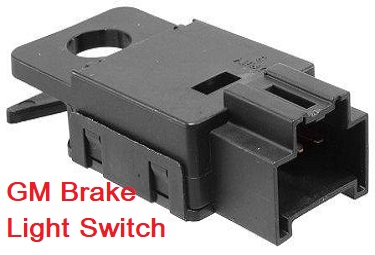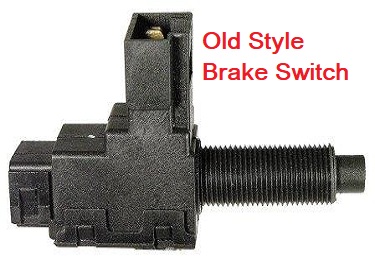Chevrolet Brake Switch Problems
Chevrolet brake switch problems remain a recurring issue that's seen on both cars and trucks for the last 25 years.
Here we'll cover three of the common problems involved with Chevrolet brake light switch failures. With that said, the issue we see most on trucks and sport utility vehicles from 2008 through 2013 is cruise control systems not working due to switch failure.
The cruise control light illuminates when the power button is pushed. However, when the driver hits the set button the vehicle will not hold the speed.
The first reaction from these drivers is they have a problem with the cruise control system. In many cases they actually experience a problem with the General Motors brake light switch.
Quick Links: Chevrolet Genuine GM Parts D1539J Brake Light Switch.
If you think about it, a light tap from the brake pedal disengages the cruise instantly. In the brake light switch failures, I've seen, the defective switch sends a signal to the cruise that the brakes are applied. This doesn’t always coincide with the brake light staying on.
Therefore, when I tell customers they need a brake light switch they often question my diagnosis. Their reasoning behind the resistance to purchase the switch comes from the brake lights working fine.
Here we'll dive into this Chevrolet brake switch problem and some older ones as well. In the final section we’ll talk about how to diagnose and replace the part and provide a video that shows how easy it is.
 Chevrolet Brake Switch Problem
Chevrolet Brake Switch ProblemChevrolet Cruise Control not Working
When I say the word Chevrolet, I hope you understand that the issue also covers GMC trucks as well. The popular Chevrolet Silverado, Tahoe and Suburban sold in larger numbers than their GMC counterparts like the Yukon. Therefore, I see a lot more Chevrolet's roll in with the cruise control issue.
Let me tell you how I first discovered and diagnosed the very first Chevrolet cruise control problem I came across.
With my prior experiences with the cheap low-quality plastic switches that GM sometimes uses, I usually head in that direction. Nevertheless, I expected to see the brake lights stuck on all the time.
Since they weren't I decided to go for a road test and try to engage the cruise control. When I hit the power button on the steering wheel controls the amber power light came on.
This fact speaks volumes about what's not wrong with the system. Including fuses, wiring and switch problems. If the power light comes on then all this stuff remains good.
When I set the cruise for 50 miles per hour the vehicle made no attempt to hold that speed. Still suspecting the brake light switch, because of my previous experience, I decided to try a little trick. I took the topside of my foot and put it underneath the brake pedal and pulled up while driving on a road with no traffic.
While I pulled up on the brake switch I hit the set button and lo and behold the cruise set. It held the speed until I removed my foot from underneath the brake pedal. At that point the cruise control thought I hit the brakes even though my foot was off the pedal. I stopped my diagnosis and purchased a replacement switch and I haven't seen the customer since.
Other Symptoms from GM Brake Switch Problems
I know a lot of drivers with Chevrolet trucks from 2008 through 2013 just decided to live without the cruise control when it stopped working. Unfortunately, avoiding the problem only lasts so long before other symptoms begin to develop. Other on-board computer operated automotive systems depend on the brake light switch input. The ABS brake system is one of those systems.
Therefore, drivers that ignore the cruise control not working, might find that the ABS light comes on. The interesting part about this is the ABS system remains tied in with other complex driving features.
As an example, drivers might receive a message, warning that the stability track needs service. Stability track operates using the ABS system so these problems are directly related. The same rule applies to the traction control warning lamp. Finally, all vehicles require you to apply the brake before it lets you shift out of park.
If the switch fails completely it stops operating the park brake interlock release mechanism. This means you can't shift out of park easily. Sometimes the switch provides an intermittent signal to the release mechanism. Drivers in this situation, report it becomes increasingly difficult to shift the vehicle out of the park position. All of these above issues point back to Chevrolet brake switch problems.
Old-style Brake Light Switch Problems
 Old Style Brake Light Switch
Old Style Brake Light SwitchDespite the importance of brake lights, General Motors has had issues with this simple on off switch over the years. The first problem I remember applied to W body automobiles built by General Motors in the early 90s.
The W body cars included the Pontiac Grand Prix and the Chevrolet Lumina. These vehicles enjoyed a reliable switch that General Motors used for years. What we didn't realize is the bracket and the adjustment device installed on the brake pedal bracket changed.
When the factory installed the brake light switch on the assembly line, they actually pushed it in a couple of clicks too far.
This meant the brake lights work just fine and nobody knew an issue existed. However, as these cars turned one or two years old they started to develop premature brake wear. It turns out the brake switch actually pushes down on the brake pedal slightly.
Unbeknownst to the drivers they were actually driving around with the brakes slightly applied. General Motors issued a technical service bulletin for the first brake job performed on W body cars. The instructions remained simple.
Grab the brake pedal and pull up on it too set the brake switch in its proper position. Almost every car I performed this procedure on would push the brake switch back about three or four clicks. This solved the premature brake wear problem.
Chevrolet Truck Brake Lights Stay On
In 1988 General Motors launched the fourth generation C/K full-size truck. These trucks came with a different style brake switch than the previous generations of Chevrolet cars and trucks.
On the assembly line the switch installed quickly with one bolt and an adjustment came with the pulling of a metal tab and then ratcheting the brake pedal. As these trucks aged they started coming in with the brake lights stuck on.
Bear in mind this includes an overwhelming amount of vehicles. At the time it the C/K truck became General Motors best selling vehicles. This also covered trucks from 1988 to 1998.
When the truck came in with the brake lights stuck on the technician could grab that same metal tab and do the same adjustment as performed on the assembly line. This repair lasted for a few months and then the driver would return with the same problem.
General Motors identified an issue that allowed the brake switch to become out of adjustment under normal operation.
The GM replacement parts team issued a new design switch so now we can fix the problem for good. If I remember correctly, they either had a special policy or a recall on the brake light switch for the CK models built during the fourth generation of the popular pickup truck.
Diagnosing Chevrolet Brake Switch Problems
As I mentioned in the opening section if you're cruise control light comes on and the system refuses to set I would just go ahead and replace the brake light switch. I believe in applying strategy based automotive electrical diagnosis and confirming failed parts. However, I have replaced too many cheap plastic switches on Chevrolet trucks and sport utility vehicles to second-guess this diagnosis.
With the low cost of the replacement part and the ease of installation it does make a lot of sense to just go ahead and give it a try. Especially, if you buy the part from Amazon or an online retailer that accepts returns. When the switches are purchased locally, they often have a no return policy. This applies to many automotive electrical devices. Retailers can tell when you plug the switches in and resist to offer a return or exchange.
Take a look at this video if you're interested in seeing how to replace a Chevrolet brake light switch. If this guy can shoot this video and fix the Chevrolet brake switch problems with one hand, I bet you can do it to.
Author bio : Mark is a retired ASE certified master technician, Chevrolet Professional Service Council member and the founder of FixMyOldRide.com. Watch the video on the about Mark the mechanic page to see his credentials. Mark hand writes all of the articles on FixMyOldRide.com unless indicated otherwise.